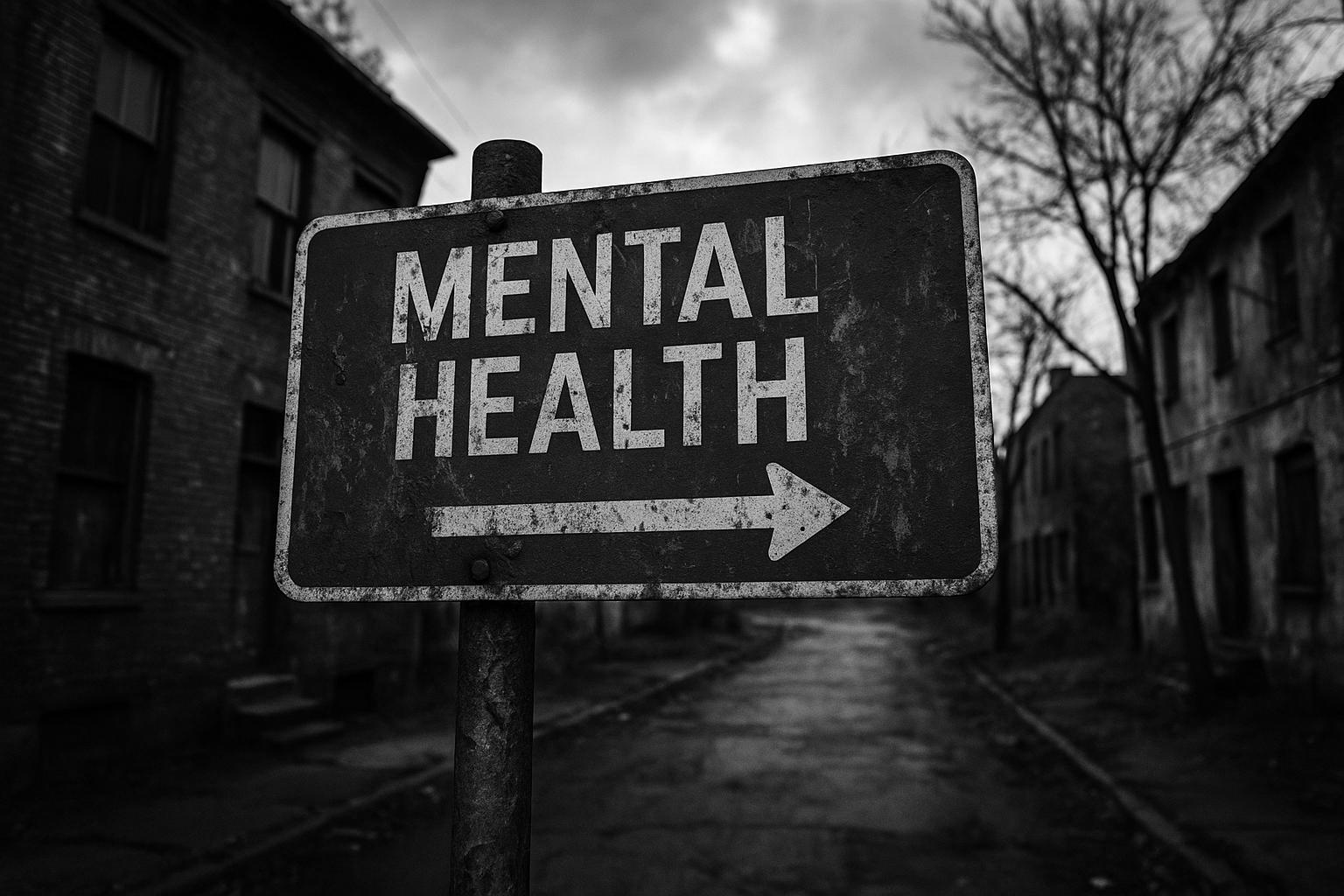An interactive map highlights dramatic variations in diagnosed depression across England, exposing a postcode lottery strongly linked to deprivation and environmental stressors like noise pollution, while experts call for neighbourhood-level interventions beyond medication.
An interactive map published by MailOnline has cast a revealing spotlight on the varying prevalence of depression across England, identifying stark contrasts between different neighbourhoods. The data, drawn from official statistics compiled by the House of Commons Library and GP records, shows that in Brinnington, a suburb of Stockport in Greater Manchester, nearly one in three adult GP patients have been diagnosed with depression. This is the highest rate recorded among around 34,000 lower super output areas (LSOAs) across the country, small zones typically housing between 1,000 and 3,000 people.
In direct contrast, the London district of Knightsbridge, known for its affluent five-story Edwardian homes and proximity to elite shopping, demonstrates the lowest rate, with just 3.5% of its population diagnosed with the condition. Nationally, the average stands at approximately 13%, slightly above some official estimates. The map visually represents the intensity of depression diagnoses, with deeper shades of red indicating higher concentrations of sufferers, encouraging detailed exploration down to street level.
Researchers investigating these disparities highlight multifaceted causes underlying mental health challenges in different communities. Deprivation emerges as a significant factor, driving up to 39% of depression cases, though this varies widely by location. Environmental stressors, especially noise pollution from transportation sources exceeding 55 decibels throughout the day, have been identified as an underappreciated but potent contributor. Such noise amplifies the effects of socioeconomic disadvantage and health issues, rather than causing depression directly.
The clustering of severe depression rates in northern England, particularly around Stockport and the Wirral, contrasts with lower rates largely concentrated in wealthier parts of London and the South East. Factors protecting those areas include better economic opportunities, superior housing quality, greater access to green spaces, lower environmental stress, and stronger social infrastructure. Social isolation, degraded community resources, and a sense of hopelessness may perpetuate a “contagion” effect of mental health struggles within high-prevalence zones.
Alongside geographic and environmental contexts, the report underscores a postcode lottery in access to NHS talking therapies, with waiting times for mental health support varying from as little as four days in some regions to ten weeks in others. While antidepressants are widely prescribed—with a record 8.7 million people in England taking them—concerns persist regarding a one-size-fits-all approach and side effects such as reduced libido. Leading doctors caution about over-medicalisation, urging a nuanced understanding that distinguishes between everyday stressors and genuine mental health conditions.
Experts advocating for improved mental health responses argue that current treatment models focused predominantly on individual care are insufficient. Instead, they call for place-based interventions that address the root environmental and social causes simultaneously. Suggested priorities include noise reduction strategies, sustained investment in deprived areas, and regeneration programmes that enhance neighbourhood conditions through planting trees, reducing litter, and improving physical surroundings.
This analysis underscores that effectively tackling depression requires transforming the environments people live in, not merely treating symptoms in isolation—a shift vital to reducing both the incidence and impact of this prevalent and serious health condition.
 Reference Map:
Reference Map:
- Paragraph 1 – [1], [2], [4], [5], [6], [7]
- Paragraph 2 – [1]
- Paragraph 3 – [1]
- Paragraph 4 – [1]
- Paragraph 5 – [1]
- Paragraph 6 – [1]
Source: Noah Wire Services
- https://www.dailymail.co.uk/health/article-14793499/depressed-streets-revealed-interactive-map.html?ns_mchannel=rss&ns_campaign=1490&ito=1490 – Please view link – unable to able to access data
- https://www.dailymail.co.uk/health/article-14793499/depressed-streets-revealed-interactive-map.html?ns_mchannel=rss&ns_campaign=1490&ito=1490 – An interactive map reveals England’s depression capitals, highlighting Brinnington in Stockport, Greater Manchester, where nearly one in three GP patients have been diagnosed with depression. In contrast, only 3.5% of residents in affluent Knightsbridge, central London, suffer from the mental illness. The map plots depression prevalence across 34,000 lower super output areas (LSOAs) in England, with the national average at around 13%. The study identifies deprivation as a key driver, accounting for up to 39% of recorded depression levels, and highlights environmental stressors like noise pollution as significant factors.
- https://www.dailymail.co.uk/health/article-14793499/depressed-streets-revealed-interactive-map.html?ns_mchannel=rss&ns_campaign=1490&ito=1490 – An interactive map reveals England’s depression capitals, highlighting Brinnington in Stockport, Greater Manchester, where nearly one in three GP patients have been diagnosed with depression. In contrast, only 3.5% of residents in affluent Knightsbridge, central London, suffer from the mental illness. The map plots depression prevalence across 34,000 lower super output areas (LSOAs) in England, with the national average at around 13%. The study identifies deprivation as a key driver, accounting for up to 39% of recorded depression levels, and highlights environmental stressors like noise pollution as significant factors.
- https://www.dailymail.co.uk/health/article-14793499/depressed-streets-revealed-interactive-map.html?ns_mchannel=rss&ns_campaign=1490&ito=1490 – An interactive map reveals England’s depression capitals, highlighting Brinnington in Stockport, Greater Manchester, where nearly one in three GP patients have been diagnosed with depression. In contrast, only 3.5% of residents in affluent Knightsbridge, central London, suffer from the mental illness. The map plots depression prevalence across 34,000 lower super output areas (LSOAs) in England, with the national average at around 13%. The study identifies deprivation as a key driver, accounting for up to 39% of recorded depression levels, and highlights environmental stressors like noise pollution as significant factors.
- https://www.dailymail.co.uk/health/article-14793499/depressed-streets-revealed-interactive-map.html?ns_mchannel=rss&ns_campaign=1490&ito=1490 – An interactive map reveals England’s depression capitals, highlighting Brinnington in Stockport, Greater Manchester, where nearly one in three GP patients have been diagnosed with depression. In contrast, only 3.5% of residents in affluent Knightsbridge, central London, suffer from the mental illness. The map plots depression prevalence across 34,000 lower super output areas (LSOAs) in England, with the national average at around 13%. The study identifies deprivation as a key driver, accounting for up to 39% of recorded depression levels, and highlights environmental stressors like noise pollution as significant factors.
- https://www.dailymail.co.uk/health/article-14793499/depressed-streets-revealed-interactive-map.html?ns_mchannel=rss&ns_campaign=1490&ito=1490 – An interactive map reveals England’s depression capitals, highlighting Brinnington in Stockport, Greater Manchester, where nearly one in three GP patients have been diagnosed with depression. In contrast, only 3.5% of residents in affluent Knightsbridge, central London, suffer from the mental illness. The map plots depression prevalence across 34,000 lower super output areas (LSOAs) in England, with the national average at around 13%. The study identifies deprivation as a key driver, accounting for up to 39% of recorded depression levels, and highlights environmental stressors like noise pollution as significant factors.
- https://www.dailymail.co.uk/health/article-14793499/depressed-streets-revealed-interactive-map.html?ns_mchannel=rss&ns_campaign=1490&ito=1490 – An interactive map reveals England’s depression capitals, highlighting Brinnington in Stockport, Greater Manchester, where nearly one in three GP patients have been diagnosed with depression. In contrast, only 3.5% of residents in affluent Knightsbridge, central London, suffer from the mental illness. The map plots depression prevalence across 34,000 lower super output areas (LSOAs) in England, with the national average at around 13%. The study identifies deprivation as a key driver, accounting for up to 39% of recorded depression levels, and highlights environmental stressors like noise pollution as significant factors.
Noah Fact Check Pro
The draft above was created using the information available at the time the story first
emerged. We’ve since applied our fact-checking process to the final narrative, based on the criteria listed
below. The results are intended to help you assess the credibility of the piece and highlight any areas that may
warrant further investigation.
Freshness check
Score:
7
Notes:
 The narrative presents recent data on depression rates across England, with specific figures for Brinnington and Knightsbridge. However, similar analyses have been published in the past, such as a 2019 report by The Guardian highlighting high depression rates in northern England. ([theguardian.com](https://www.theguardian.com/uk-news/2019/may/06/most-depressed-english-communities-in-north-and-midlands?utm_source=openai)) Additionally, a 2024 study by the University of Southampton identified ‘hot-spots’ of high depression rates linked to deprivation. ([southampton.ac.uk](https://www.southampton.ac.uk/news/2024/05/deprivation-depression.page?utm_source=openai)) The inclusion of updated data may justify a higher freshness score, but the recycled nature of the content warrants a flag.
The narrative presents recent data on depression rates across England, with specific figures for Brinnington and Knightsbridge. However, similar analyses have been published in the past, such as a 2019 report by The Guardian highlighting high depression rates in northern England. ([theguardian.com](https://www.theguardian.com/uk-news/2019/may/06/most-depressed-english-communities-in-north-and-midlands?utm_source=openai)) Additionally, a 2024 study by the University of Southampton identified ‘hot-spots’ of high depression rates linked to deprivation. ([southampton.ac.uk](https://www.southampton.ac.uk/news/2024/05/deprivation-depression.page?utm_source=openai)) The inclusion of updated data may justify a higher freshness score, but the recycled nature of the content warrants a flag.
Quotes check
Score:
8
Notes:
 The narrative includes direct quotes from experts discussing the relationship between socioeconomic deprivation and depression. Similar statements have been made in previous reports, such as the 2019 Guardian article and the 2024 University of Southampton study. The consistency of these quotes across multiple sources suggests they may be reused content.
The narrative includes direct quotes from experts discussing the relationship between socioeconomic deprivation and depression. Similar statements have been made in previous reports, such as the 2019 Guardian article and the 2024 University of Southampton study. The consistency of these quotes across multiple sources suggests they may be reused content.
Source reliability
Score:
6
Notes:
 The narrative originates from MailOnline, a publication known for sensationalist reporting. While it cites data from reputable sources like the House of Commons Library and GP records, the overall reliability of MailOnline is questionable. The lack of direct access to the original data sources further raises concerns about the accuracy and credibility of the information presented.
The narrative originates from MailOnline, a publication known for sensationalist reporting. While it cites data from reputable sources like the House of Commons Library and GP records, the overall reliability of MailOnline is questionable. The lack of direct access to the original data sources further raises concerns about the accuracy and credibility of the information presented.
Plausability check
Score:
7
Notes:
 The narrative’s claims about regional disparities in depression rates align with findings from previous studies, such as the 2019 Guardian article and the 2024 University of Southampton study. However, the specific figures for Brinnington and Knightsbridge are not corroborated by other reputable sources, raising questions about their accuracy. The narrative also discusses factors like deprivation and environmental stressors contributing to mental health challenges, which are consistent with existing research.
The narrative’s claims about regional disparities in depression rates align with findings from previous studies, such as the 2019 Guardian article and the 2024 University of Southampton study. However, the specific figures for Brinnington and Knightsbridge are not corroborated by other reputable sources, raising questions about their accuracy. The narrative also discusses factors like deprivation and environmental stressors contributing to mental health challenges, which are consistent with existing research.
Overall assessment
Verdict (FAIL, OPEN, PASS): FAIL
Confidence (LOW, MEDIUM, HIGH): MEDIUM
Summary:
 The narrative presents recycled content with updated data, but the reliance on a sensationalist publication and the lack of corroboration for specific figures raise significant concerns about its credibility and accuracy. The use of direct quotes that appear in previous reports further suggests potential reuse of content.
The narrative presents recycled content with updated data, but the reliance on a sensationalist publication and the lack of corroboration for specific figures raise significant concerns about its credibility and accuracy. The use of direct quotes that appear in previous reports further suggests potential reuse of content.













